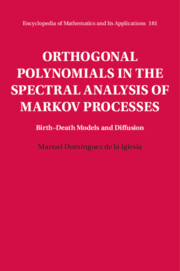 Orthogonal Polynomials in the Spectral Analysis of Markov Processes
Orthogonal Polynomials in the Spectral Analysis of Markov Processes 3 - Spectral Representation of Birth–Death Processes
Published online by Cambridge University Press: 08 October 2021
Summary
This chapter is devoted to the spectral analysis of birth–death processes on nonnegative integers, which are the most basic and important continuous-time Markov chains. These processes will be characterized by an infinitesimal operator which is a tridiagonal matrix whose spectrum is always contained in the negative real line (including 0). The Karlin–McGregor integral representation formula of the transition probability functions of the process is obtained in terms of orthogonal polynomials with respect to a probability measure with support inside a positive real interval. Although many of the results are similar or equivalent to those of discrete-time birth–death chains, the methods and techniques are quite different. The chapter gives an extensive collection of examples related to orthogonal polynomials, including the M/M/k queue for any k servers, the continuous-time Ehrenfest and Bernoulli–Laplace urn models, a genetics model of Moran and linear birth–death processes. As in the case of discrete-time birth–death chains, the Karlin–McGregor formula is applied to the probabilistic aspects of birth–death processes, such as processes with killing, recurrence, absorption, the strong ratio limit property, the limiting conditional distribution, the decay parameter, quasi-stationary distributions and bilateral birth–death processes on the integers.
Information
- Type
- Chapter
- Information
- Orthogonal Polynomials in the Spectral Analysis of Markov ProcessesBirth-Death Models and Diffusion, pp. 146 - 253Publisher: Cambridge University PressPrint publication year: 2021